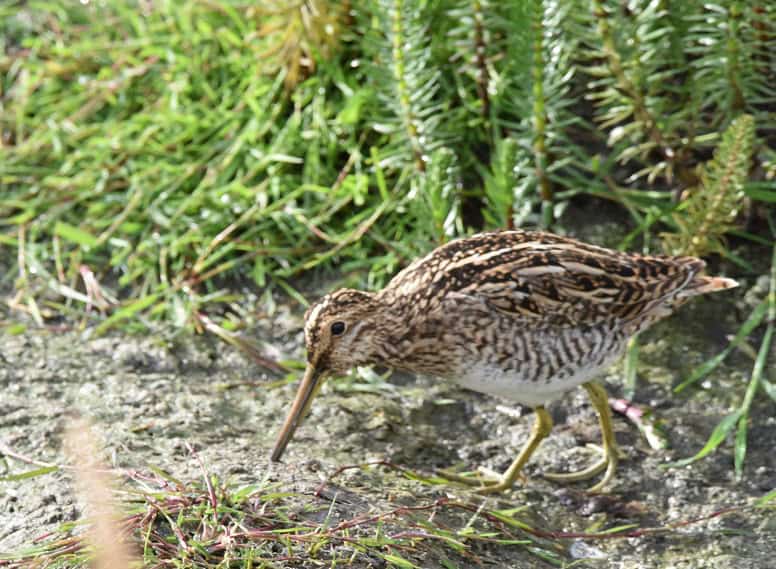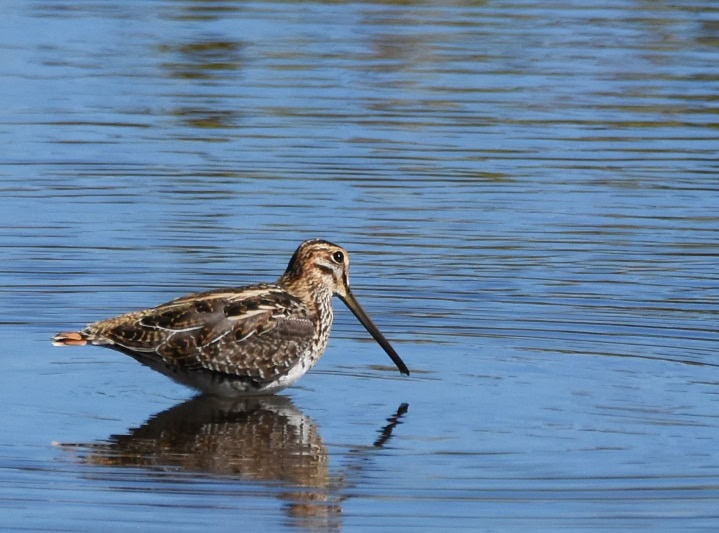
What is a Snipe? – Definition
- To criticise someone or to shoot at them.
- A bird with a long beak that lives in a wet area.
Which came first, the Bird or the Shooter?
Answer: The bird.
The name snipe comes from the Middle English “snype”, which means to have a long beak. Similar words exist in old Norse and old German.
Apparently, Snipes were difficult for hunters to hit due to their erratic flight pattern. Thus, someone who was good at shooting them became known as a sniper.
Description
Snipes are medium-sized birds with short legs and a very long bill. In fact, the bill and the legs are about the same length. They are mottled with brown, rufous, black and white on the back and are therefore well camouflaged. Some have yellowish stripes on each side of the back. Most species’ breast and belly are white with brown bars on the upper breast and along the sides. The amount of baring varies from species to species, with some primarily white and others mostly barred.
Taxonomy
Snipes are members of the Scolopacidae family, which is mainly composed of Sandpipers but also includes Snipes and eight species of Woodcocks.
Woodcocks and Snipes are similar, but Woodcocks are larger and live in forested areas. Snipes are smaller than Woodcocks but have a longer bill. Both have a brownish, mottled back, but Woodcocks have a cinnamon belly, while Snipes have a white belly. Woodcocks have stripes across their head, while Snipse do not.
Habitat
Although Snipes are members of the same family as Sandpipers, their habitats differ. Snips are usually near water, but I have never seen one on a beach where there are often Sandpipers and Plovers.
Diet
Snipes eat mainly insect larvae but also crustaceans and worms. They feed by sticking their long bill into soft dirt or mud. They suck up their victims like a straw while keeping their beak closed to avoid eating dirt.
The Snipe
There are 22 Species of Snipe worldwide. They all look basically the same, with only minor differences.
The Magellanic Snipe lives in southern South America and the Falkland Islands. It is a bit lighter in colour than most snipes. Photo above.
The Common Snipe lives mainly in Iceland, Europe, and Scandinavia but also in the Middle East, southern Asia, and northern Africa.
The Jack Snipe lives mainly in Europe and Scandinavia. It is similar to the Common Snipe but darker with more black and has a yellow/orange stripe on each side of its back.

Wilson’s Snipe is a typical snipe found in North America, as far south as Columbia, and also in the Caribbean islands.
The Great Snipe looks like other snipes, but, as the name implies, it is much larger. at 26–30 cm (10–12 in) in length, although there are a few other large snipes as well. It is found mostly in Brazil and Paraguay but also Venezuela and neighbouring Guianas.
Swinhoe’s Snipe is found in Mongolia and SE Asia.
Pantanal Snipe is found throughout northern South America and as far south as northern Argentina.
The Pintailed Snipe is found in Southeast Asia and the southeast tip of the Arabian Peninsula around the UAE and Oman.
Latham’s Snipe is found in eastern Australia, Japan and a few nearby islands. It is near-threatened.
The Solitary Snipe is found in the Himalayan Mountains, Mongolia, South Korea, and Japan.
The African Snipe is found in eastern and southern Africa, from Ethiopia to South Africa. It is one of the darker snipes like the Jack Snipe.
The Wood Snipe lives in the Himalayan Mountains of Nepal and China and in a few neighbouring SE Asian countries. It is classified as Vulnerable and has a population of between 2,500 and 10,000.
The Giant Snipe is found in two separate areas in South America: southern Brazil and Paraguay and the north coast from Venezuela to French Guiana. It is the largest snipe at 36 to 47 cm (14 to 19 in) in length.
The Subantarctic Snipe lives on the Aukland, Campbell, and Antipodes Islands south of New Zealand and is classified as Near Threatened.
The Fuegian Snipe lives in southern Chile and the extreme tip of Argentina. It is classified as Near Threatened.
Jameson’s Snipe is found in the Andes Mountains from Venezuela to Bolivia. Unlike most snipes, it has a barred breast and belly instead of a white one.
The Noble Snipe lives in the Andes Mountains of Columbia and Ecuador. It is classified as Near Threatened.
The Snares Snipe is found only on Stewart Island, New Zealand and the Snares Islands, which are 200 km south of Stewart Island. It is classified as Near Threatened.
The Imperial Snipe is found in the Andes Mountains of Ecuador and Peru. Unlike other snipes, the Imperial Snipe is a bright, rufous colour, mottled with black. The only white is on the face, lower belly, and undertail. it is classified as Near Threatened.
The Madagascar Snipe is found, you guessed it, on the island of Madagascar. It is classified as Vulnerable and has a population between 1,800 and 7,500.
The Chatham Island Snipe is found, as the name implies, on the Chatham Islands, 800 km east of New Zealand. It is classified as Vulnerable and has a population of less than 2,000.
The Puna Snipe lives in the Andes Mountains of Peru, Bolivia, and northern Chile.
Extinct Species
In addition to the above list, there are several species of snipe that are now extinct.
Painted Snipe
The Painted Snipe looks very different and is not related to these snipes.